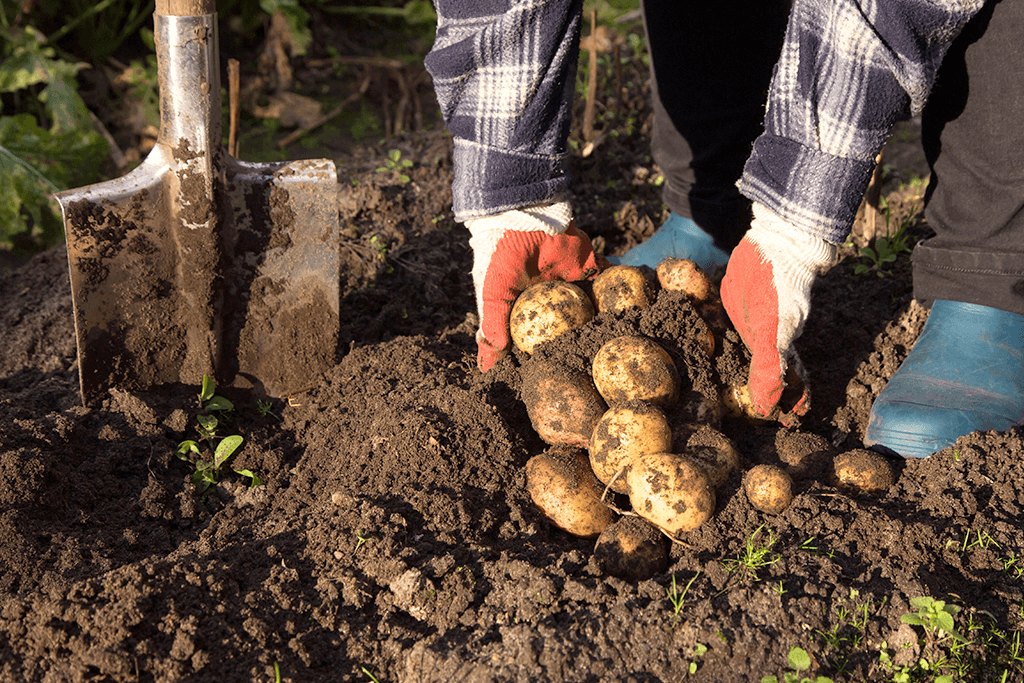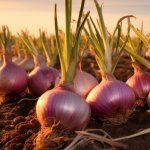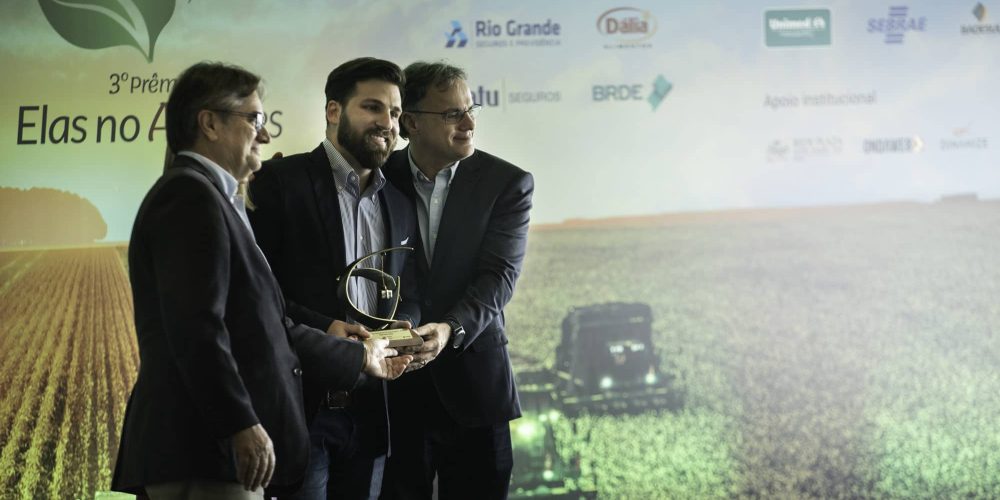In Brazil, potatoes are the most important vegetable, with an average annual production of approximately 3.7 million tons in an area of around 117 thousand hectares (FAOSTAT, 2022). Potato farming is a source of income that involves around 5 thousand producers in 30 regions of seven Brazilian states (EMBRAPA, 2018). Potato production in Brazil has two segments, potatoes for fresh consumption and the segment for industry with two types: potato chips and pre-fried frozen potatoes, mainly in the form of sticks (FREITAS et al., 2022).
High productivity is achieved through appropriate cultivation practices which require crop rotation, use of quality seed potatoes, water availability, adequate phytosanitary control and fertilization (PEREIRA, 2021).
Fertilization is one of the main factors that influence productivity and, among vegetables, potatoes are considered one of the most demanding species in terms of fertilization (Table 1), with this practice being essential in determining the quality and quantity of tubers produced (FILGUEIRA, 2008).
Table 1. Quantities of nutrients extracted from the soil by potato crops to produce one ton of tubers.

Approximately 78% of phosphorus (P), 68% of potassium (K), 65% of nitrogen (N), 65% of sulfur (S), 33% of magnesium (Mg) and 9% of calcium (Ca) absorbed by the potato plant are accumulated in the tubers. As for micronutrients, approximately 49% of copper (Cu), 45% of boron (B) and 41% of zinc (Zn) absorbed by the crop throughout the cycle are accumulated in the tubers, while the absorption of iron (Fe) and manganese (Mn) represents 20% and 11%, respectively, of the total absorbed by the potato plant (Embrapa Hortaliças).
The appropriate time of application, as well as the period and dose of each nutrient, is also important for the nutritional balance of the plant to obtain high productivity. Considering a cycle of 90 to 110 days, the maximum absorption of N, P, Ca, Mg and S occurs in the initial phase of tuber filling (45 to 70 days after planting - DAP). K absorption is more concentrated between 40 and 60 DAP. The phase of greatest demand for B occurs right after the beginning of tuber formation, between 35 and 50 DAP, while the greatest demand for Fe and Mn begins at 45 DAP and continues until 65 DAP. Cu and Zn are absorbed in greater proportions in the second half of the crop cycle (Embrapa Hortaliças).
Now let's talk specifically about NPK in increasing productivity in potato crops.
Nitrogen (N)
Nitrogen (N) is of great importance because it is fundamental in plant development and interferes in the balance between vegetative and reproductive growth (ALVA, 2004). Furthermore, it is the second most absorbed macronutrient by potato crops (FERNANDES et al., 2011), whose tuber productivity depends on the nitrogen fertilization provided to the crop and/or the availability of this nutrient in the soil (GETAHUN et al., 2019).
Potato productivity depends indirectly on the amount of photosynthetically active leaf area responsible for the synthesis of carbohydrates in the leaves and subsequent mobilization of these photoassimilates to the developing tubers (ASUNCIÓN, 2020). However, in the final phase of the potato crop cycle, both photoassimilates and N are remobilized from the aerial part to the tubers, causing a reduction in leaf longevity (MILLARD et al., 1989; SILVA; PINTO, 2005), which results in a shorter cycle duration and, consequently, lower productivity.
NO is the nutrient responsible for controlling the development of potato plants, since it acts by boosting the growth of the aerial part, in addition to contributing to the production of large tubers (SORATTO et al., 2017). However, its absorption does not occur continuously throughout the plant development cycle. After tuberization, as there is an almost linear increase in the tuber growth rate (FERNANDES et al., 2010b), the amounts of N absorbed by the plants increase considerably, reaching daily N absorption rates of up to 2.4 kg ha-1 day-1 during the tuber filling phase (FERNANDES et al., 2011; FERNANDES; SORATTO, 2012). Thus, the greatest demand for N by potato plants occurs during the tuber filling phase, with plants absorbing up to 49% of their total demand in the first 20 days of this phase, and up to 39% of the total accumulated demand during the entire cycle in the next 27 days (FERNANDES et al., 2011). However, most producers usually apply topdressing nitrogen up to this phase (± 40 DAP). N absorption by potato plants tends to be reduced in the final phase of the tuber filling and plant maturation period (ZOTARELLI et al., 2014). These studies show that there is a late absorption of N by potato plants, even after 60 DAP (FERNANDES et al., 2011; FERNANDES; SORATTO, 2012), and perhaps for this reason, often, the application of N only in the implementation and initial growth phase of the crop is not sufficient to make adequate amounts of N available in the soil during the phase of greatest demand by the plants and, consequently, guarantee high tuber productivity.
Phosphorus (P) and Potassium (K)
The application of P2THE5 and K2It should be done at planting (Table 2). If the P and/or K levels in the soil are classified as “Very high” and with values three times above the critical level, it is not recommended to apply P and/or K.
In subsequent crops, it is recommended to perform new soil sampling and a new recommendation. As a preventive measure, as a source of micronutrients, it is recommended to supply part of the N or P (which reaches 20 kg/ha of N or P).2THE5 first) with an organic fertilizer.
Table 2 – Phosphorus and potassium requirements for potato crops.
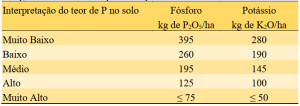
Phosphorus (P)
Phosphorus (P) is considered a nutrient for starch synthesis, playing a major role in the quality of tubers (size and specific weight), percentage of dry matter, ascorbic acid and proteins, in addition to the high amount of dry matter in the tuber being something desired by the processing industry, as it ensures less retention of frying oil and consequently greater crispness and texture in the final product (PERES, 2022). Approximately 65% of potato production in Brazil is destined for the fresh market, 15% for the chips industry, 12% for the pre-fried industry and 8% for seed potatoes. All production is maintained in the domestic market, with there still being a need for imports, mainly of frozen potatoes and seeds (MARCOMINI, 2020).
Despite the importance of P in the development of the tuber of this crop, this nutrient is the cause of a problem in the field for producers, due to its high fixation in Brazilian soil (FERNANDES et al., 2016). The fixation of nutrients in a soil occurs when these, which were previously in a soluble form, become less soluble, due to the reaction between other compounds, resulting in less mobility and accessibility for plants (PERES, 2022).
Potassium (K)
Among the nutrients absorbed by potato crops, potassium (K) stands out, which is absorbed and extracted in large quantities and is extremely important for crop development. K increases productivity and provides higher quality tubers in potatoes. Inadequate potassium management, whether in terms of doses or application time, can limit crop productivity. K is applied in lower doses than P and extracted in greater quantities, influencing the quality and quantity of tubers. It acts in several metabolic functions, such as enzyme activator, respiration and protein synthesis; stomatal opening, phloem transport, osmoregulation, cation/anion balance; required by plants for sugar translocation and starch synthesis (FREITAS et al., 2022).
Since potato crops have a high K requirement, due to the tubers, for the most part, being rich in starch, K plays a crucial role. The enzyme starch synthetase is activated by K. K deficiency reduces plant growth, shortening the internodes, with wilted leaves arched downwards and irregular shapes. In extreme cases, the edges of older leaves become reddish to necrotic (FREITAS et al., 2022).
It is a highly available element and highly subject to leaching, with little influence in successive crops. The mechanisms that explain how K remains in the soil, that is, its residual effect, are not well understood, and it is necessary to observe some important aspects, such as: predominant type of clay, organic matter content, cation exchange capacity (CEC), moisture retention capacity, available K content, intensity and type of crop explored (FREITAS et al., 2022). There are several studies that prove that K has the ability to increase plant height and crop vigor, playing an important role not only morphologically but also physiologically, since it influences the performance of carbohydrate translocation from leaves to tubers (JASIM et. al., 2013). For a yield of 30 t of potato tubers, approximately 214 kg of K are required.2O. The amount of potassium exported in the tubers is equivalent to 61% of the total nutrient absorbed by the crop. (PEREIRA et al., 2014)
The application of K via foliar application is an interesting alternative, in the form of potassium sulfate and potassium thiosulfate, since potato cultivars intended for industry are sensitive to potassium chloride, the main source provided at planting, due to the interaction of chloride in the metabolism of plants, with the increase in reducing sugars, an undesirable factor for the industry (FREITAS et al., 2022).
In potato cultivation, final tuber productivity depends on the plant's ability to produce DM, the percentage of DM that is allocated to tuber growth, and the moisture content present in the tubers (EWING, 1997). Thus, since potato productivity depends on the plant's ability to synthesize carbohydrates in the leaves and mobilize them to the growing tubers, maintaining a larger photosynthetically active leaf area in the late stages of the crop cycle may be favorable for tuber production, because the accumulation of biomass in plants is directly related to the amount of photosynthetically active radiation intercepted by the crop (MONTEITH, 1977; STÖCKLE; KEMANIAN, 2009; SANDAÑA; KALAZICH, 2015).
Brazil imports approximately 79% of NPK fertilizers (nitrogen, phosphorus, and potassium), with an increase rate of up to 6% per year. Regarding the high sufficiency of phosphate fertilizers, the country can supply only 45% of the total demand, the other 55% coming from imports (SEAE, 2020). Given the environmental impacts due to the inappropriate use and high prices of fertilizers, the use of chemicals is being redirected in search of new alternatives that can circumvent these problems, but can offer the same results (FERNANDES et al., 2020). Among the new fertilizer alternatives, organomineral fertilizers, which consist of a mixture of mineral and organic fertilizers, stand out. The mineral particle is surrounded by an organic resin that ensures the solubilization of the nutrient, such as phosphorus and potassium, inside it and its release in a controlled manner, which will guarantee its greater efficiency (ALMEIDA et al., 2012). The slow release characteristic reduces the loss of phosphorus through adsorption, by avoiding immediate contact with the oxides present in the soil (FERNANDES et al., 2020).
Fertilization recommendations for most cultivated species are made according to the nutritional demand of each cultivar and no longer in a general way for all cultivars of the same species. Potato cultivars have different nutritional demands that also depend on the soil and climate characteristics to which they are subjected (FERNANDES et al., 2011b; LUZ et al., 2014; WEBER; MIELNICZUK, 2009). Determining the nutritional demand of each cultivar, as well as the variation of this demand throughout the cycle, are essential parameters for fertilization recommendations. This recommendation tends to respect the absorption capacity of plants in order to avoid loss of nutrients and unnecessary expenditure on fertilizers (ZOBIOLE et al., 2010).
ILSA Fertilization Plan
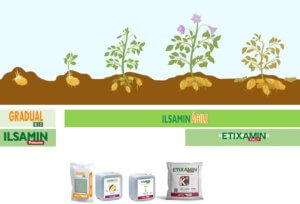
ILSA BRASIL has a complete line of fertilizers capable of meeting all the nutritional requirements of potato crops. The GRADUAL Mix planting line® for supplying macronutrients comes from the AZOGEL matrix® which has in its composition organic nitrogen that will be available for a longer period of time during the crop cycle, allowing balanced vegetative growth, organic carbon that will promote greater microbial activity and amino acids that will directly interfere in several metabolic processes in the potato plant and also enhance the absorption of nutrients from mineral raw materials (phosphorus and potassium) contained in the fertilizer, due to its complexing capacity. Even at the time of crop establishment, ILSA BRASIL recommends the application of ILSAMIN POTENTE® which is obtained by combining the organic matrix GELAMIN® with humic substances capable of promoting and stimulating the rooting of seed tubers, increasing the plants' capacity to absorb water and nutrients, allowing a more standardized and uniform initial stand of plants.
Regarding fertilizers obtained from the GELAMIN matrix® ILSAMIN Agile fertilizer® applied via leaves, it has a high concentration of amino acids that directly interfere in the secondary metabolism of plants, increasing their resilience to adverse climatic factors. ILSAMIN Kally® applied also via leaves, its main objective is to increase and enhance the filling of tubers through the efficient supply of potassium, sulfur and amino acids, which together promote greater translocation of photoassimilates and more uniform and heavier tubers.
References
ALMEIDA, Luciana Venturotti Braun de et al. Nutrient availability and growth of citrus rootstocks fertilized with conventional and slow-release fertilizers. Brazilian Journal of Fruit Growing, v. 34, p. 289-296, 2012.
ALVA, A. Potato nitrogen management. Journal of Vegetable Crop Production, vol. 10, p. 97-132, 2004.
ASSUNÇÃO, Natália Silva. Potato productivity and quality in response to nitrogen fertilization management. SÃO PAULO STATE UNIVERSITY. 2020.
CQFS-SOIL CHEMISTRY AND FERTILITY COMMISSION. Liming and fertilization manual for the states of Rio Grande do Sul and Santa Catarina. Brazilian Society of Soil Science, 2016.
EMBRAPA. Potato production system. Available at: https://www.embrapa.br/cultivoscriacoesesistemasdeproducao?p_p_id=conteudoportlet_WAR_sistemasdeproducaolf6_1ga1ceportlet&p_p_lifecycle=0&p_p_state=normal&p_p_mode=view&p_p_col_id=column2&p_p_col_count=1&p_r_p_76293187_sistemaProducaoId=8803&p_r_p_996514994_topicoId=1301. 2018.
EWING, E. E. Potato. In: WIEN, HC The physiology of vegetable crops. Wallingford: Cab International, 1997, p. 295-344.
GETAHUN, Baye Berihun et al. Genetic diversity of potato cultivars for nitrogen use efficiency under contrasting nitrogen regimes. Potato Research, v. 63, p. 267-290, 2019.
FERNANDES, Adalton Mazetti et al. Growth, accumulation and distribution of dry matter in potato cultivars in the winter harvest. Brazilian Agricultural Research, v. 45, p. 826-835, 2010.
FERNANDES, AM; SORATTO, RP; SILVA, BL Extraction and export of nutrients in potato cultivars: I – Macronutrients. Brazilian Journal of Soil Science, v. 35, p. 2039-2056, 2011.
FERNANDES, AM; SORATTO, RP Mineral nutrition, liming and fertilization of potato. Botucatu: FEPAF; Itapetininga: ABBA, 2012. 121 p.
FERNANDES, Adalton M. et al. Influence of phosphorus on the quality and productivity of tubers of dual-purpose potato cultivars. Brazilian Horticulture, v. 34, p. 346-355, 2016.
FERNANDES, Pedro Henrique et al. Use of organomineral phosphate fertilizers in the cultivation of lettuce and corn in succession. Brazilian Journal of Development, v. 6, no. 6, p. 37907-37922, 2020.
FILGUEIRA, FAR New Manual of Olericulture: modern agrotechnology in the production and marketing of vegetables. 2nd ed. Viçosa: UFV, 2008, 421 p.
FREITAS, Hugo Lourenço et al. Foliar fertilization with potassium sources in potatoes, cvs. Asterix and Markies. FEDERAL UNIVERSITY OF UBERLANDIA. 2022.
JASIM, AH; HUSSEIN, MJ; NAYEF, MN Effect of foliar fertilizer (high in potash) on growth and yield of seven potato cultivars (Solanum tuberosomL.). Euphrates Journal of Agricultural Science 5: 1-7, 2013.
KAWAKAMI, J. Reduction of fertilization and nitrogen doses and splitting on potato growth and productivity. Horticultura Brasileira, v. 33, p. 168-173, 2015.
LUZ, JMQ; QUEIROZ, AA; OLIVEIRA, RC Critical leaf nitrogen content in “Asterix” potato as a function of nitrogen doses. Horticultura Brasileira, Brasília, v. 32, n. 2, p. 225–229, 2014.
MARCOMINI, GR Competitive advantages in potato production in Brazil and the United States. Business Administration in Review, [Sl], v. 4, n. 22, p. 246 -270, May 2021.
MILLARD, P.; ROBINSON, D.; MACKIE-DAWSON, LA Nitrogen partitioning within the potato (Solanum tuberosum L.) plant in relation to nitrogen supply. Annals of Botany, vol. 63, p. 289-296, 1989.
MONTEITH, JL Climate and the efficiency of crop production in Britain. Philosophical Transactions of the Royal Society of London, vol. 281, p. 277-294, 1977.
PEREIRA, Gabriel Emiliano. Growth, productivity and nutritional demands of potato cultivars and economic evaluation of nitrogen fertilization of the Asterix cultivar. UNIVERSITY OF BRASILIA. 2021.
PEREIRA, Emanuel ac, et al. Potassium in potatoes is the quality nutrient. Field and Business On line. 2014.
PERES, Diego Silva. Mineral and organomineral phosphate fertilization in potato crops, cv. Asterix. FEDERAL UNIVERSITY OF UBERLANDIA. 2022.
SEAE – SPECIAL SECRETARIAT FOR STRATEGIC AFFAIRS. National fertilizer production. July 2020. Available at: https://www.gov.br/planalto/pt-br/assuntos/assuntosestrategicos/documentos/estudosestrategicos/sae_publicacao_fertilizantes_v10.pdf.
SILVA, LAS; PINTO, CABP Duration of the growth cycles and yield potential of potato genotypes. Crop Breeding and Applied Biotechnology, vol. 5, p. 20-28, 2005.
SORATTO, RP; FERNANDES, AM; JOB, ALG Nutrition, liming and fertilization. In: Nick, C.; Borém, A. Potato from planting to harvest. 1st ed. Viçosa: Editora UFV, 2017, v.1, p. 51-76.
STÖCKLE, C.; KEMANIAN, A. Crop radiation capture and use efficiency: a framework for crop growth analysis. In: Sadras, VO; Calderini, DF Crop Physiology: applications for genetic improvement and agronomy. San Diego: Academic Press, 2009, p.145-170.
WEBER, MA; MIELNICZUK, J. Soil nitrogen stock and availability in a long-term experiment. Brazilian Journal of Soil Science, Campinas, v. 33, n. 2, p. 429–437, 2009.
ZOBIOLE, Luiz Henrique Saes et al. Macronutrient absorption pattern in sunflower crops. Brazilian Journal of Soil Science, v. 34, p. 425-434, 2010.
ZOTARELLI, Lincoln et al. Nitrogen fertilizer rate and application timing for chipping potato cultivar Atlantic. Agronomy Journal, v. 106, no. 6, p. 2215-2226, 2014.
Authors
Agr Eng. Dr. Angélica Schmitz Heinzen
Agricultural Eng. Msc. Carolina Custodio Pinto
Agricultural Eng. Msc. Thiago Stella de Freitas

